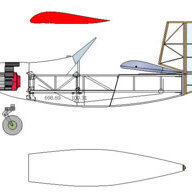Hi guys,
I joined this forum a few years back, and for some reason it dropped off my radar. I have just been reminded of its existence again, and so here I am, back again.
I know this is an old thread, but hey - since when has age ever been a barrier to folks like us? There are very few amateurs today who actually are designing brand new aircraft starting with a blank sheet. I'm one of them. And I'm glad to find some others here as well.
I started out planning to build a KR2. But I couldn't find enough decent wood (I was living in Auckland at the time). So I bought a set of Sonex plans, and discovered that I didn't like the zillions of little bits of aluminium which had to be rivited together. Besides, I didn't like working with the stuff. So I began to think composite. My dad and I built a number of very early composite surfboards way back in the 60's when no-one knew what the hell they were doing. But I liked the process.
So I began looking for suitable composite kit planes. There was nothing I could afford. The idea struck me that I should save money, and design my own. HAH! Save money? Not...
Almost four years later, I have finally got a grasp on what aircraft design entails, have received a lot of peer advice (and criticism), and have thrown away more than a dozen "final" designs. I've also discarded a half dozen plugs. One only got as far as the basic shell. I have completed five other plugs, made adjustments to them, fixed errors, changed dimensions etc till they were so mutilated, I had to chop them up and begin again. One of these was abandoned when I moved from Auckland to Brisbane. Each time I restarted the process, I went into lockdown mode, and made significant changes to the basic design. I have tried low wing, high wing and now I've settled on a mid-wing configuration. I've gone from tailwheel to tricycle. Over the years I've acquired three engines: a Suzuki 3-cylinder (sold it - too hard to convert), a BMW K75 (trying to sell it - too heavy) and now a Valley Engineering Big Twin. This is an already aero-converted engine, 50hp, 116lbs including reduction drive, started, alternator, oil.
With the aid of WizardWorks (a 3-D Wizard mate on the homebuiltairplanes.com web site) I now have plug # 6 ready to go. All template files are currently at the CNC shop, and foam is on order. The last plug took me 8 months of sometimes daily labour to get to the stage where I was ready to make molds. Then I decided to change the tail for better spin recovery, and to widen the cockpit. The new plug (with new and improved construction method) will be ready for molds within a few weeks from starting. Well, that's the plan.
So - if you're reading this thinking that you might give designing a plane a go - do it, mate. Do it. But don't expect it to be quick, cheap or simple. Hopefully, however, you will end up with a unique and ultimately satisfying design you can truly call your own.
More info on my design can be found on my web site:
http://rtfmaero.wordpress.com/
Regards,
Duncan









